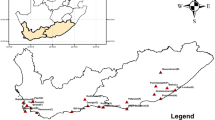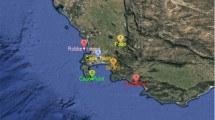Abstract
The dependency effect to extreme value distributions (EVDs) using the frequentist and Bayesian approaches have been used to analyse the extremes of annual and daily maximum wind speed at Port Elizabeth, South Africa. In the frequentist approach, the parameters of EVDs were estimated using maximum likelihood, whereas in the Bayesian approach the Markov Chain Monte Carlo technique with the Metropolis–Hastings algorithm was used. The results show that the EVDs fitted considering the dependency and seasonality effects with in the data series provide apparent benefits in terms of improved precision in estimation of the parameters as well as return levels of the distributions. The paper also discusses a method to construct informative priors empirically using historical data of the underlying process from other weather stations. The results from the Bayesian analysis show that posterior inference might be affected by the choice of priors used to formulate the informative priors. The Bayesian approach provides satisfactory estimation strategy in terms of precision compared to the frequentist approach, accounting for uncertainty in parameters and return levels estimation.





Similar content being viewed by others
References
Azzalini A (1996) Statistical inference: based on the likelihood. Chapman and Hall, London
Barlow AM, Rohrbeck C, Sharkey P, Shooter R, Simpson ES (2018) A Bayesian spatio-temporal model for precipitation extremes—STOR team contribution to the EVA2017 challenge. Extremes 21:431–439
Behrens C, Lopes H, Gamerman D (2004) Bayesian analysis of extreme events with threshold estimation. Stat Model 4:227–244
Beirlant J, Goegebeur Y, Segeres J, Teugels J (2004) Statistics of extremes, 1st edn. Wiley, Chichester
Brabson BB, Palutikof JP (2000) Tests of the generalised Pareto distribution for predicting extreme wind speeds. J Appl Meteorol 39:1627–1640
Caires S (2009) A comparative simulation study of the annual maxima and the peaks over-threshold methods. Deltares report 1200264-002 for Rijkswaterstaat, Waterdienst
Coles SG (2001) An introduction to statistical modeling of extreme values. Springer, London
Coles SG, Powell EA (1996) Bayesian methods in extreme value modelling: a review and new developments. Int Stat Rev 64:119–136
Coles SG, Tawn JA (1996) A Bayesian analysis of extreme rainfall data. Appl Stat 45:463–478
Coles SG, Tawn JA (2005) Bayesian modelling of extreme surges on the UK east coast. Philos Trans R Soc A 363:1387–1406
Cunnane C (1973) A particular comparison of annual maxima and partial duration series methods of flood frequency prediction. J Hydrol 18:257–271
Davison AC, Smith RL (1990) Models for exceedances over high thresholds (with discussion). J R Stat Soc B 52:393–442
De Oliveira MMF, Ebecken NFF, De Oliveira JLF, Gilleland E (2011) Generalised extreme wind speed distributions in South America over the Atlantic Ocean region. Theor Appl Climatol 104:377–385
De Paola F, Giugni M, Garcia-Aristizabal A, Bucchignani E (2018) GEV Parameter estimation and stationary vs. non-stationary analysis of extreme Rainfall in African test Cities. Hydrology 5(2):28
Diriba TA, Debusho LK, Botai J (2015) Modeling extreme daily temperature using generalized pareto distribution at port Elizabeth, South Africa, peer-reviewed. In: Proceedings of the 57th annual conference of the South African statistical association, University of Pretoria, Pretoria, South Africa, pp 41–48
Diriba TA, Debusho LK, Botai J, Hassen A (2017) Bayesian modelling of extreme wind speed at Cape Town, South Africa. Environ Ecol Stat 24:243–267
Diriba TA (2018) Analysis of extreme climate events in South Africa. Ph.D. thesis, University of Pretoria
Faranda D, Lucarini V, Turchetti G, Vaienti S (2011) Numerical convergence of the block maxima approach to the generalised extreme value distribution. J Stat Phys 145(5):1156–1180
Fawcett L, Walshaw D (2006) A hierarchical model for extreme wind speeds. Appl Stat 55(5):631–646
Ferreira A, De Haan L (2014) The generalised Pareto process; with a view towards application and simulation. Bernoulli 20(4):1717–1737
Ferreiara A, De Haan L (2015) On the block maxima method in extreme value theory: PWM estimators. Ann Stat 43(1):276–298
Ferro C, Segers J (2003) Inference for clusters of extreme values. J R Stat Soc B 65:545–556
Gilleland E, Katz RW (2011) New software to analyze how extremes change over time. Eos Trans Am Geophys J 92(2):13–14
Hastings WK (1970) Monte Carlo sampling methods using Markov chains and their applications. Biometrika 57:97–109
Hundecha Y, St-Hilaire A, Ouarda T, El Adlouni S (2008) A Non-stationary extreme value analysis for the assessment of changes in extreme annual wind speed over the Gulf of St. Lawrence, Canada. J Appl Meteorol Climatol 47:2745–2759
IPCC (2018) Summary for Policymakers. In: Global warming of 1.5\(^{\circ }\text{C}\). An IPCC special report on the impacts of global warming of 1.5\(^{\circ }\text{ C }\) above pre-industrial levels and related global greenhouse gas emission pathways, in the context of strengthening the global response to the threat of climate change, sustainable development, and efforts to eradicate poverty. World Meteorological Organization, Geneva, Switzerland, p 32
Jenkinson AF (1955) The frequency distribution of the annual maximum (or minimum) values of meteorological elements. Q J R Meteorol Soc 87:158–171
Jocković J (2012) Quantile estimation for the generalised Pareto distribution with application to finance. Yugoslav J Oper Res Soc 22:2334–6043
Kearns P, Pagan A (1997) Estimating the density tail index for financial time series. Rev Econ Stat 79:171–175
Kruger AC (2011) Wind climatology of South Africa relevant to the design of the built environment. Ph.D. thesis, University of Stellenbosch
Kruger AC, Retief JV, Goliger AM (2013) Strong winds in South Africa: Part 2. Mapping of updated statistics. J S Afr Inst Civ Eng 55(2):46–58
Lazoglou G, Anagnostopoulou C (2017) An overview of statistical methods for studying the extreme Rainfalls in mediterranean. In: Proceedings of 2nd international electronic conference on atmospheric sciences, Aristotle University of Thessaloniki, Thessaloniki, Greece, p 681
Leadbetter MR, Lindgren G, Rootzén H (1983) Extremes and related properties of stationary sequences and processes. Springer, New York
Madsen H, Pearson CP, Rosbjerg D (1997) Comparison of annual maximum series and partial duration series methods for modelling extreme hydrologic events 2. Regional modelling. Water Resour Res 33:759–769
Martins ES, Stedinger JR (2001) Historical information in a generalised maximum likelihood framework with partial duration and annual maximum series. Water Resour Res 37:2559–2567
Mélice JL, Reason CJ (2007) Return period of extreme rainfall at George, South Africa. S Afr J Sci 103(11–12):499–501
Metropolis N, Rosenbluth MN, Teller AH, Teller E (1953) Equations of state calculations by fast computing machine. J Chem Phys 21(6):1087–1091
Pickands J (1975) Statistical inference using extreme order statistics. Ann Stat 3:119–131
Sang H, Gelfand A (2009) Hierarchical modelling for extreme values observed over space and time. Environ Ecol Stat 16:407–426
Smith RL (1989) Extreme value analysis of environmental time series: an application to trend detection in ground-level ozone. Stat Sci 4(4):367–393
Stephenson AC (2003) Multivariate extreme value distributions and their application. Ph.D. thesis, Lancaster University
Stephenson AG (2016) ismev: an introduction to statistical modeling of extreme values. R package version 1.41. http://www.ral.ucar.edu/~ericg/softextreme.php
Stephenson AG (2018) evd: functions for extreme value distributions. R package version 2.3-3. https://cran.r-project.org
Stephenson AG, Ribatet MA (2006) A user’s guide to the evdbayes. R package version 1.1. http://www.cran.r-project.org/
Von Mises R (1954) La distribution de la plus grande de n valeurs. In: Selected papers II. American Mathematical Society, pp 271–294
Wang QJ (1991) The POT model described by the generalised Pareto distribution with Poison arrival rate. J Hydrol 129:263–280
Acknowledgements
The authors are very indebted to the University of South Africa for the financial support. The authors would also like to thank the South African Weather Service for providing the data.
Author information
Authors and Affiliations
Corresponding author
Additional information
Publisher's Note
Springer Nature remains neutral with regard to jurisdictional claims in published maps and institutional affiliations.
Appendix: Posterior density plots
Appendix: Posterior density plots
Rights and permissions
About this article
Cite this article
Diriba, T.A., Debusho, L.K. Modelling dependency effect to extreme value distributions with application to extreme wind speed at Port Elizabeth, South Africa: a frequentist and Bayesian approaches. Comput Stat 35, 1449–1479 (2020). https://doi.org/10.1007/s00180-019-00947-2
Received:
Accepted:
Published:
Issue Date:
DOI: https://doi.org/10.1007/s00180-019-00947-2






